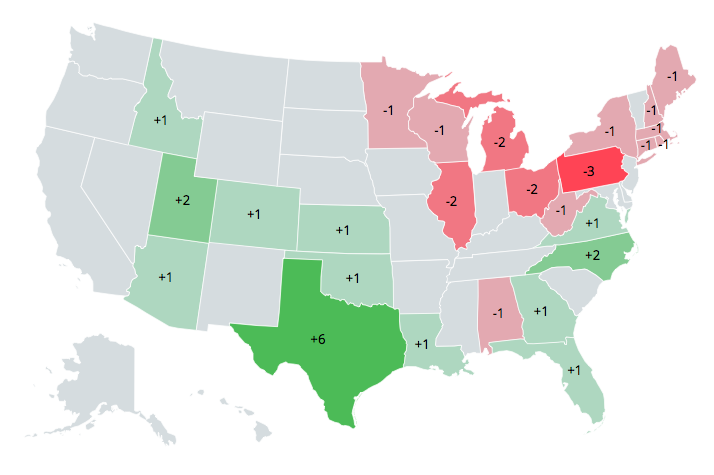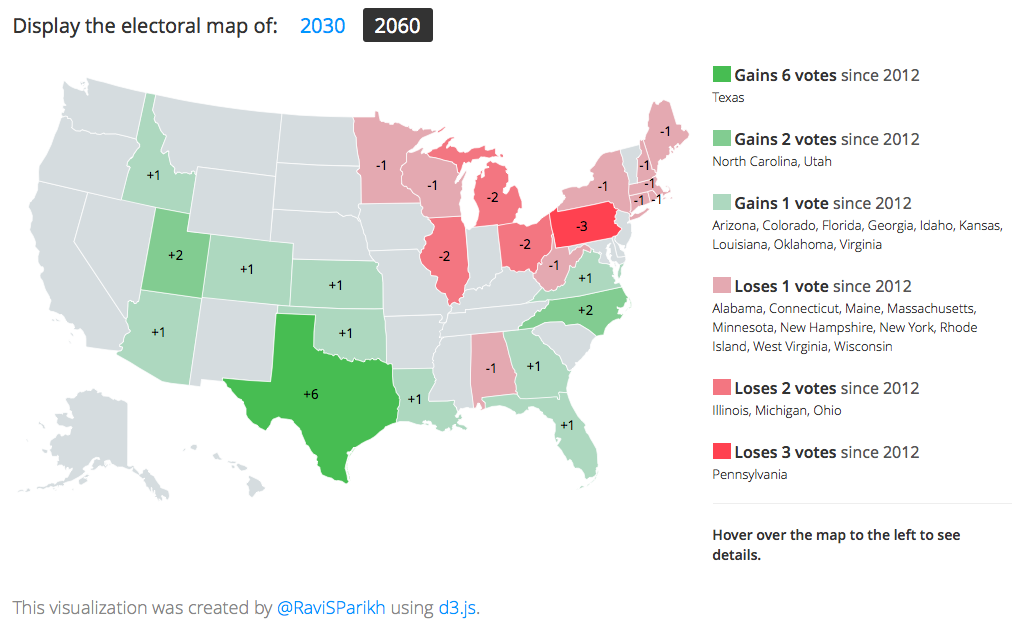Demographers: The South, and its political clout, will keep rising

According to recent projections, Southern states will gain twice as many Congressional seats as the rest of the country combined in the next 50 years. (Maps by Ravi Parikh)
In the 20-year span between 2010 and 2030, Harris County, Texas -- home of Houston, the nation's fourth-largest city -- will add more people to its population than the entire state of Pennsylvania. In North Carolina, Charlotte-led Mecklenburg County will gain a greater number of residents than Philadelphia County in Pennsylvania.
These demographic realities, documented by the data firm ProximityOne, highlight a central theme in U.S. politics today: the rising influence and importance of the South.
As Facing South has shown over the years, the nation's political gravity has been steadily shifting to the South, largely at the expense of Rust Belt states like Pennsylvania. Today, nearly one-third (32 percent) of the Electoral College votes needed to be elected president are in 13* Southern states.
According to demographers, the South is expected to keep growing -- and with it, the region's political clout. Drawing on these projections, Ravi Parikh of the analytics firm Heap has created a set of interesting maps (first reported in The Washington Post) that visualize what the South's growing political power will look like in the coming decades.
Using population estimates for 2030 and 2060, Parikh plots how the South's booming population will likely translate into more Congressional seats and Electoral College votes. Here is the map for which states are expected to gain and lose by 2030:

In this scenario, Louisiana -- rebounding from its devastating population losses after Hurricane Katrina -- will join North Carolina, Texas and Virginia in adding six Congressional seats in the South, largely at the expense of the Midwest and Rust Belt.
By 2060, Southern states are projected to gain 12 Congressional seats, with other states in the Great Plains and West gaining just seven. The biggest losers: Illinois, Michigan, Ohio and especially Pennsylvania, which -- if current trends hold up -- will lose three seats in the next half-century:

What does this mean for the future of U.S. politics? Today, of course, Republicans dominate Southern politics, but the forces driving the South's growth -- the region's increasingly diverse, multiracial population -- are making the region increasingly competitive.
Texas, where two-thirds of the state's population growth has been driven by Latinos, is the clearest example. The trend is also clear in a state like North Carolina, which is projected to pick up one Congressional seat by 2030 and another by 2060.
As the voter advocacy group Democracy North Carolina showed in a recent report [pdf], the state's dramatic demographic changes -- reflected in places like Mecklenburg County, which recently became a so-called "majority minority" area -- are increasingly reflected in the state's electorate.
While whites made up 81 percent of North Carolina voters 20 years ago, they represent 71 percent of registered voters today. Meanwhile, African Americans are 23 percent of N.C. voters, up from 18 percent in 1993, and Latino voters, while still less than 2 percent of the electorate, have doubled their numbers in just five years.
* The Institute includes Alabama, Arkansas, Georgia, Florida, Kentucky, Louisiana, Mississippi, North Carolina, South Carolina, Tennessee, Texas, Virginia and West Virginia in its definition of the South.
Tags
Chris Kromm
Chris Kromm is executive director of the Institute for Southern Studies and publisher of the Institute's online magazine, Facing South.
